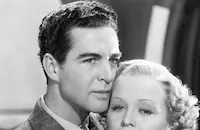Walking Down Broadway
Cast & Crew
Norman Foster
Claire Trevor
Phyllis Brooks
Leah Ray
Dixie Dunbar
Lynn Bari
Film Details
Technical Specs

Synopsis
On New Year's Eve in New York's Times Square, as the Manhattan Revue closes its run, six chorus girls who share a dressing room sign an agreement to meet at a reunion on the next New Year's Eve at the ritzy Manhattan Terrace. The girls are Sandra De Voe, who has landed a Hollywood contract; Jerry Lane, who is in love with Tom Douglas, an underling to investment counselor Peter Claybourne; Vicki Stone, with whom Peter is infatuated; Joan Bradley, who secretly loves Peter; Tiny Bronson, whom the others tease for her seeming lack of intelligence; and Linda Martin, who toys with the idea of taking up with a gambler even though she has a young daughter. Outside the theater, Sandra is hit by a truck and killed. By the winter, Tiny has secured a role in a new Broadway show, while Joan goes to designing school. Tom is depressed that he cannot give Jerry expensive gifts or take her to fancy places. Although she is satisfied with only his love, Jerry encourages him to ask Peter for a raise, but Peter puts him off. When Vicki, who is dating both Peter and gambler Frank Gatty, brags that she can keep four men at one time if she wants, Joan is disgusted. Envious of Vicki, Linda takes a job as a singer at the infamous Baccarat Club, despite Joan's warnings. When Peter, who works much of the time in Boston, arrives unexpectedly while Vicki is with Gatty, Joan, despite her feelings toward Peter, covers for Vicki. The next day, however, a photograph of Vicki and Gatty leaving the Baccarat Club appears in a newspaper. When Vicki, suspicious of her, implies that Joan will tell Peter, Joan slaps her, but after Peter sees the picture, Joan explains that she herself got involved with Gatty and that they took Vicki "slumming" when the photo was taken. Not satisfied with the story, Peter returns to Boston. Sometime later, Peter surprises Vicki embracing Gatty. He does not believe Vicki's excuse and tells her that he had come anyway to break off with her. Distressed, Vicki goes to the balcony and threatens to jump if he does not say that he believes her. Peter just laughs, and Vicki actually does fall to her death as a loose railing on which she leans gives way. Joan helps Peter avoid a scandal, and after the death is ruled an accident, Peter sends Joan a check for $5,000, which she refuses to cash. Later, an admirer whom Joan has rejected helps her get a job as a designer. Bob Randall, the son of her firm's owner, is interested in Joan, but he goodheartedly accepts her rejection of his advances. At the Baccarat Club, Gatty accuses the owner, Ace Wagner, of having crooked dice and goes for his gun. Ace shoots him and then gives his gun to Linda. As the wounded Gatty is about to shoot back, Linda, at Ace's instigation, plugs Gatty, who dies. After Ace falsely testifies that Linda fired both shots, a jury convicts her of second-degree murder. At Christmas, Tom confesses to Jerry that he embezzled money from Peter to play the stock market. He says he intended to return the money, but worries that Peter will soon find out. Tom plans to go away, and because Jerry wants to accompany him, Joan takes her to get help from Peter. Peter, who has reported the theft, is unwilling to try to get the warrant for Tom's arrest lifted, and he berates the women, saying that their "false idea of success" led Tom to steal. Furious, Joan tells Peter off. Peter then has his attorney call off the warrant and gives Jerry money for Tom, so that they can leave for South America. Joan, who plans to sail with Linda's daughter Sunny to France on New Year's Eve to take over the Paris salon, will not accept messages from Peter. As her boat is ready to depart, Joan, in tears, rips up the agreement she and the others signed the previous New Year's Eve. Sunny is not able to comfort Joan; however, Peter arrives at the dock with flowers and a ticket for himself, and he and Joan reconcile.

Director

Norman Foster
Cast

Claire Trevor

Phyllis Brooks
Leah Ray
Dixie Dunbar
Lynn Bari
Jayne Regan

Michael Whalen

Thomas Beck

Douglas Fowley
Walter Woolf King
Jed Prouty
Robert Kellard

Joan Carol

Leon Ames

William Benedict
Maurice Cass
Gennaro Curci
Sam Mcdaniel
Allen Fox
Frank Hagney
Bert Roach
Forbes Murray
William Worthington
Sherry Hall
Robert Graves
Franklin Parker
Claire Du Brey
Spec O'donnell
Ernie Alexander

Paul Fix
Jack Perry
Maurice Black
Robert Homans
Charles Delaney
Arthur Rankin
Charles Tannen
Paul Mcvey

Lon Chaney Jr.
Crew
Harry Akst
William H. Anderson
Robert Chapin
Sidney Clare
Norman Colbert
Lewis Creber
Karen De Wolf
Ed. Ebele
Mark Hellinger
Herschel
Bernard Herzbrun
Samuel Kaylin
Kathryn Lambert
George Leverett
Virgil Miller
Aaron Rosenberg
Sol M. Wurtzel

Film Details
Technical Specs

Quotes
Trivia
Notes
The working title of this film was Six Girls. According to information in the Twentieth Century-Fox Records of the Legal Department at the UCLA Theater Arts Library, Kathryn Lambert claimed that this film was an infringement of her newspaper story, "I Kept My Date with Five Ghosts!" which appeared in the Sunday Mirror magazine section on July 5, 1936. Lambert's story relates that in 1916, she and five other Ziegfeld Follies' chorus girls, Olive Thomas, Lilyan Tashman, Martha Mansfield, Bessie Poole and Effie Alsop, made a pact to meet in twenty years to see how their lives developed. In 1936, however, Lambert, who had become a producer, was the only one still alive. According to Lambert, Thomas killed herself by drinking poison; Tashman's death was said to have been due to extreme dieting; Mansfield died in a fire while on location for the 1924 film The Warrens of Virginia; Poole died after an incident in a New York nightclub; and Alsop, who had married a man worth $27 million, died destitute in a rooming house. Correspondence in the legal records indicates that producer Sol Wurtzel saw articles about Lambert's story and forwarded them to Julian Johnson, head of the studio's scenario department, and then Johnson forwarded it to Broadway columnist Mark Hellinger to work on. No information concerning the outcome of Lambert's claim has been located. According to a Variety news item in July 1936, Twentieth Century-Fox hired Hellinger to develop the story, then entitled "Six Girls and Death." They permitted him to work in the East, with the proviso that he fly to the coast if necessary. In October 1936, according to Variety, William Conselman, who was writing the screenplay, went to New York to confer with Hellinger. The legal records state that Robin Harris wrote material based on Conselman's work, but that the final screenplay by Robert Chapin and Karen De Wolf was based only on Hellinger's story and not on Conselman's or Harris' contributions. According to the legal records, Hellinger "felt that the story as ultimately included in the picture has no resemblance to the outline he wrote and therefore he has requested that screen credit for him be omitted." Ultimately, Hellinger's name did not appear in the screen credits.
Motion Picture Herald noted that the studio publicized this film as presenting six "stars of tomorrow," Claire Trevor, Phyllis Brooks, Dixie Dunbar, Leah Ray, Lynn Bari and Jayne Regan. Some reviews noted similarities between this film and Stage Door, the successful 1936 Edna Ferber, George S. Kaufman play, which RKO released as a film in October 1937. Motion Picture Herald commented, "The parts played by the girls are somewhat similar to the show girl habitues who made up the boardinghouse contingent in Stage Door." Variety noted that the film includes newsreel clips of a New Year's celebration on Broadway. Robert Lowery is listed as a cast member in Hollywood Reporter production charts, but his participation in the final film has not been confirmed.












